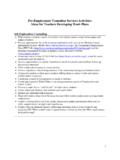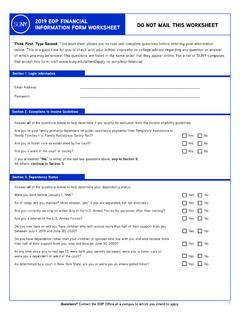Transcription of Pre-Employment Transition Services Activities: Ideas for ...
1 Pre-Employment Transition Services activities : Ideas for Teachers Developing Work Plans Job Exploration Counseling Help students complete interest inventories and explore careers using various paper and online resources. Provide opportunities for work on career exploration tools such as the Montana Career Information System (MCIS) ( ), the Personalized employment Plan (PEP Talk) ( ) and the Montana Department of Labor & Industry Career Resources website ( ). Assist students to explore O*NET OnLine ( ), a tool for career exploration and job analysis. Provide opportunities to explore Transition -to-Work inventories and facilitate follow-up discussions afterward. Offer a high school course on career choices. Provide experience interviewing workers in the community during local business tours. Arrange for students to hear guest speakers talking about a variety of jobs and careers (online and/or in person).
2 Coordinate a panel of entrepreneurs to speak to students. Coordinate a panel of Tribal Elders or an intergenerational panel on employment and Native Trades. Provide a career fair or real life fair for high school students. Create virtual job shadows that students can watch online. Explore pre-apprenticeship programs. Share information about the differences between labor market employment and negotiated employment . Conduct a Group Discovery Class in the classroom to gather information about student skills, support needs, strengths and experiences. Teach a class on financial literacy, addressing questions such as: Can I work if I am receiving SSI? What would I want to spend money on from my first job? How much money do I need to earn? 1. Work-Based Learning Experiences Coordinate with local Job Service personnel to provide in-school sessions and/or visits to the local Job Service office. Build a network of local community-based work experiences, including opportunities for one- day job shadows and longer term work experiences.
3 Facilitate job shadowing and mentoring at local businesses. Identify individuals who have disabilities and can offer first-hand accounts to share with students about their work-based experiences. Coordinate chaperones and transportation for students to take advantage of work-based learning experiences. Organize a group of community members (including parents) who can help identify and recruit work experience sites in the community. Provide job coaches to facilitate work-based learning experiences for students. Develop a system for gathering information about student skills, support needs, strengths and experiences from each work experience. Connect students with adult agencies that provide ongoing employment supports after graduation. Consider adult agencies and the school co-supporting youth in work experiences and paid jobs before graduation. Learn about what is happening with economic development in the local community.
4 Enroll students in the Montana Registered Apprenticeship program for work experience. Explore the possibility of a pre-apprenticeship in the health care trades (scaled down to meet the needs of people with intellectual disabilities and those who need hands-on experience to develop skills). Partner with One-Stop Centers and Job Service offices on work-based learning opportunities. Enroll students in Jobs for Montana's Graduates. Help students access summer Youth employment Programs through Workforce/HRDCs. Connect with other local agencies, organizations and service clubs committed to preparing workforce members, such as Chambers of Commerce, Rotary, Lions Clubs, etc. Explore corporate internship opportunities. EnvisionIT (EIT) is 21st century, standards-aligned, online curriculum for grades 8-12 that teaches English and Languages Arts, Information Technology Literacy, College & Career Readiness, and Financial Literacy.
5 2. Counseling Students on Opportunities for Enrollment in Comprehensive Transition or Post-Secondary Education Support students in compiling a Transition binder with relevant agency/organization contact information (for example, Vocational Rehabilitation and college support Services ). Provide opportunities to participate in College in a Day at local college campuses. Support students to participate in the Movin' On in Montana campus experience. Invite recent graduates back to school to talk about their experiences transitioning to college and the differences between high school and college. Collect examples of college application paperwork and discuss needed requirements with students. Learn about accommodations for college entrance testing and SAT and ACT test preparation. Collaborate with the school counselor to provide opportunities to discuss post-secondary education options and visit local post-secondary education campuses.
6 Invite the local Vocational Rehabilitation and Blind Services (VRBS) counselor to present information to students about the VRBS program. Offer a Trades Rodeo for students to learn more about practical trades, including opportunities for apprenticeships and ways of learning on the job in a trade or industry. Collaborate with math teachers and/or college staff to offer specific lessons on financial planning and budgeting for college and how to research financial aid opportunities such as Pell grants, ABLE (Achieving a Better Life Experience) accounts, and PASS (Plan to Achieve Self-Support) plans. Educate students on the differences between special education Services in high school and disabled student Services on campus. Help students learn about various supports and assistive technology used by students with disabilities at college, such as where and how to get alternative formats of textbooks.
7 Provide students with resources to learn about TRiO Student Support Services , TRIO- Upward Bound, and Disability Services for Students. Explore statewide Job Corps options. Plan a visit with students to a local Job Corps campus. Explore electronic mentoring between high school students and college students with disabilities. Explore dual enrollment options at local colleges for high school and college credit. 3. Workplace Readiness Training Offer soft skills training to facilitate awareness of social skills and personal strengths and challenges in the workplace. Explore existing soft skills training, for example: through local Job Service offices;. Easter Seals-Goodwill Peer Connections ( programs/autism-asd- ); Missoula-based JOBS's (Job Opportunity-Based Services ) Job Ready program ( ); MYTransitions' Soft Skills Academies ( ); and the Office of Disability employment Policy's (ODEP) Skills to Pay the Bills curriculum ( ).
8 Assist students with workplace readiness training using Transition curriculum from Life Centered Education Curriculum or Attainment Company Access soft skills for employment curricula through Workforce trainers, MYTransitions staff, employers, and/or Centers for Independent Living. Teach students the importance of self-management skills at work, home and school. Teach students strategies to promote independence at work such as time management, moving from task to task, and self-monitoring production and performance. Teach students to use assistive technology that will enable them to be independent at work. Support students to explore job-specific and disability-specific assistive technology, as well as how to pay for the assistive technology. Support students to develop competent communication for the workplace. Develop strategies for augmentative and alternative communication if needed. Have students participate in financial readiness classes through local banks.
9 Teach basic banking and budgeting skills. Offer financial literacy instruction addressing such topics as getting a paycheck, calculating the impact of wages on SSI, reporting wages to the Social Security Administration, applicable Social Security work incentives, saving, and budgeting. Teach workplace vocabulary. Provide and discuss examples of job descriptions, compensation and taxes, workplace expectations, and evaluation/performance appraisal documentation. Provide opportunities to practice form completion and the gathering of required documentation/verification (for example, financial aid forms, background check applications, health information and insurance paperwork, picture identification cards, and W-9 tax forms). Provide opportunities for students to take the WorkKeys evaluations at registered sites either in school or at local Job Service offices. Teach workplace expectations such as work hours and breaks, vacation time, annual holidays, personal hygiene, maintenance of uniforms, health and safety requirements, etc.
10 Offer opportunities for students to learn basic first aid for the workplace. Partner with the Regional Transition Committee for Ideas around workplace readiness. 4. Partner with the local Center for Independent Living for Ideas and support around workplace readiness. Provide transportation and travel training. Determine if travel trainers are available through Vocational Rehabilitation and Blind Services (VRBS) or the local Center for Independent Living. Enroll students in Jobs for Montana Graduates. Connect students with the Summit Independent Living Center-BASE Program improvisation class. Support students to participate in job shadows. (Additional support may be available through MYTransitions, VRBS, and Job Service.). Explore community resources such as the Lions Club, Rotary, Job Service, Chamber of Commerce, Small Business Advisory Council and the Small Business Development Council. Connect with other schools that have Pre-Employment Transition Services Ideas and information to share.



